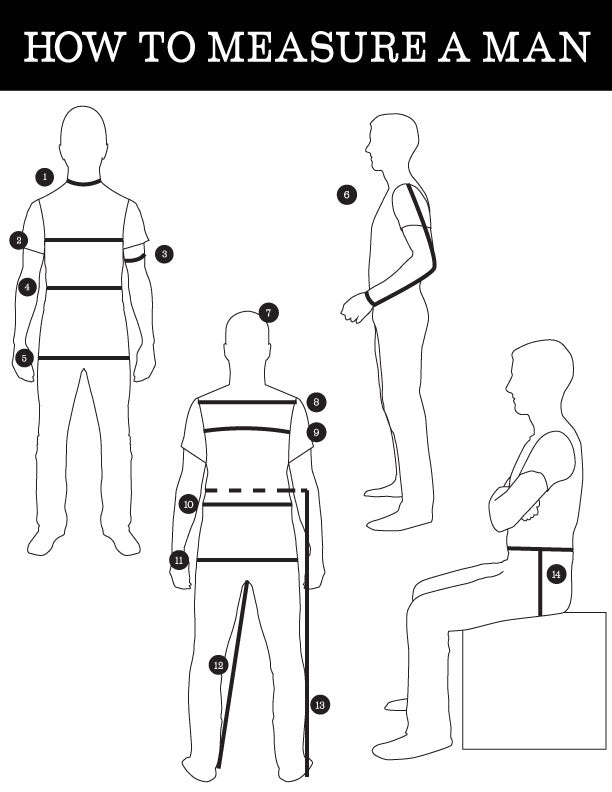

Eager to learn more?
Sift through our pattern hacks, sewing technique tutorals and guest blog posts by selecting from the filter below-left.
Tutorials
How to Measure a Man

1. Neck Circumference: Measure around the base of the neck loosely.
2. Chest Circumference: An important measurement! Circle the tape measure around the chest underneath the armpits. Make sure the tape measurement is at the widest point of the chest. Raise the tape slightly along the back so that it sits over the shoulder blades. See #9 for more detail.
3. Arm Circumference: Measure around the bicep with the arm bent so the muscle is engaged.
4. Waist Circumference: Tie a string or narrow elastic around the body to determine the narrowest point. Circle the tape measure around this point.
5. Hip/Seat Circumference: Circle the tape measure around the fullest part of the seat. Make sure the tape measure is level with the ground rather than being angled in any way.
6. Sleeve Length: Bend the arm slightly as pictured. Measure from the shoulder bone to the wrist placing the tape measure over the curve of the elbow.
7. Wrist Circumference: Measure around the wrist just above the wrist bone.
8. Shoulder Width: Measure across the back at the widest point from the position where a sleeve seam sits.
9. Chest Circumference: As mentioned in #2, raise the tape measure slightly so that it crosses the protruding shoulder bones. This an important step to determine the true circumference of the chest because the amount individual’s shoulder blades protrude can differ greatly.
10. Trouser Waist: This position can differ depending on the style of pants. Keep in mind that the Body Measurement Chart for all of our patterns includes the Natural Waist Circumference while the Garment Measruement Chart includes the Trouser Waist Circumference. This makes it easy to compare these two measurements and determine your size!
11. Hip/Seat Circumference: Circle the tape measure around the fullest part of the seat. Make sure the tape measure is level with the ground rather than being angled in any way.
12. Inside Leg/Inseam: To determine the inside leg length, measure high in the crutch (the point where the leg meets the crotch) to the heel of the shoe. To measure a desired inseam length it can be more accurate to measure existing pants to account for the ease between the body’s crutch point and the actual pants crotch.
13. Side Seam Length: Measure from the waist (where the string or elastic is tied) to the heel of the shoe. Since pant rise can differ greatly (and is often lower than the natural waist level), find a desired side seam length by measuring existing pants with the same rise as the pants you intend to sew.
14. Body Rise: With the man sitting on a stool or chair so his knees are bent approximately 90 degrees, measure the depth from the trouser waist (rather than the natural waist), to the top of the stool or chair.
Download a printable PDF of this information!
